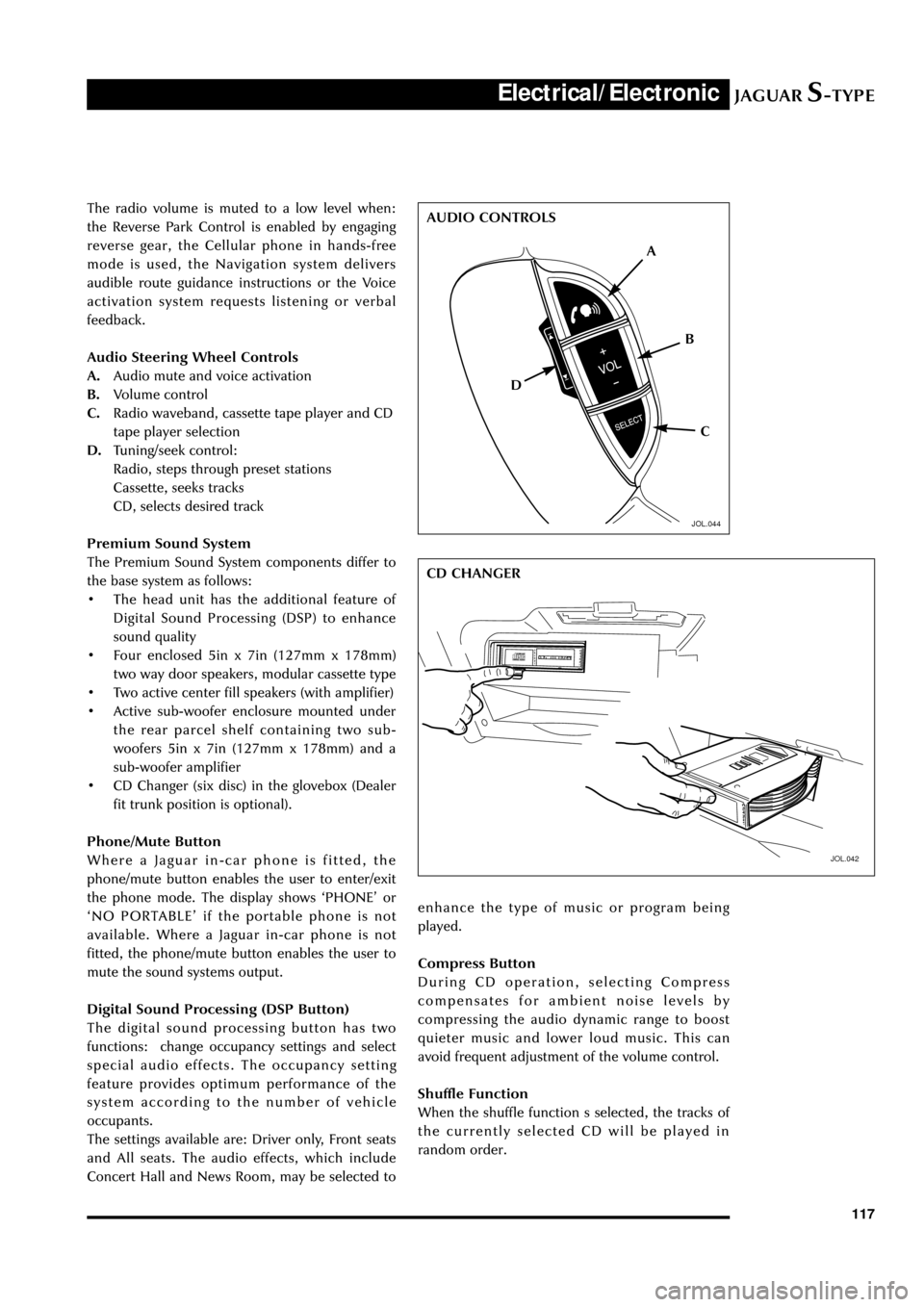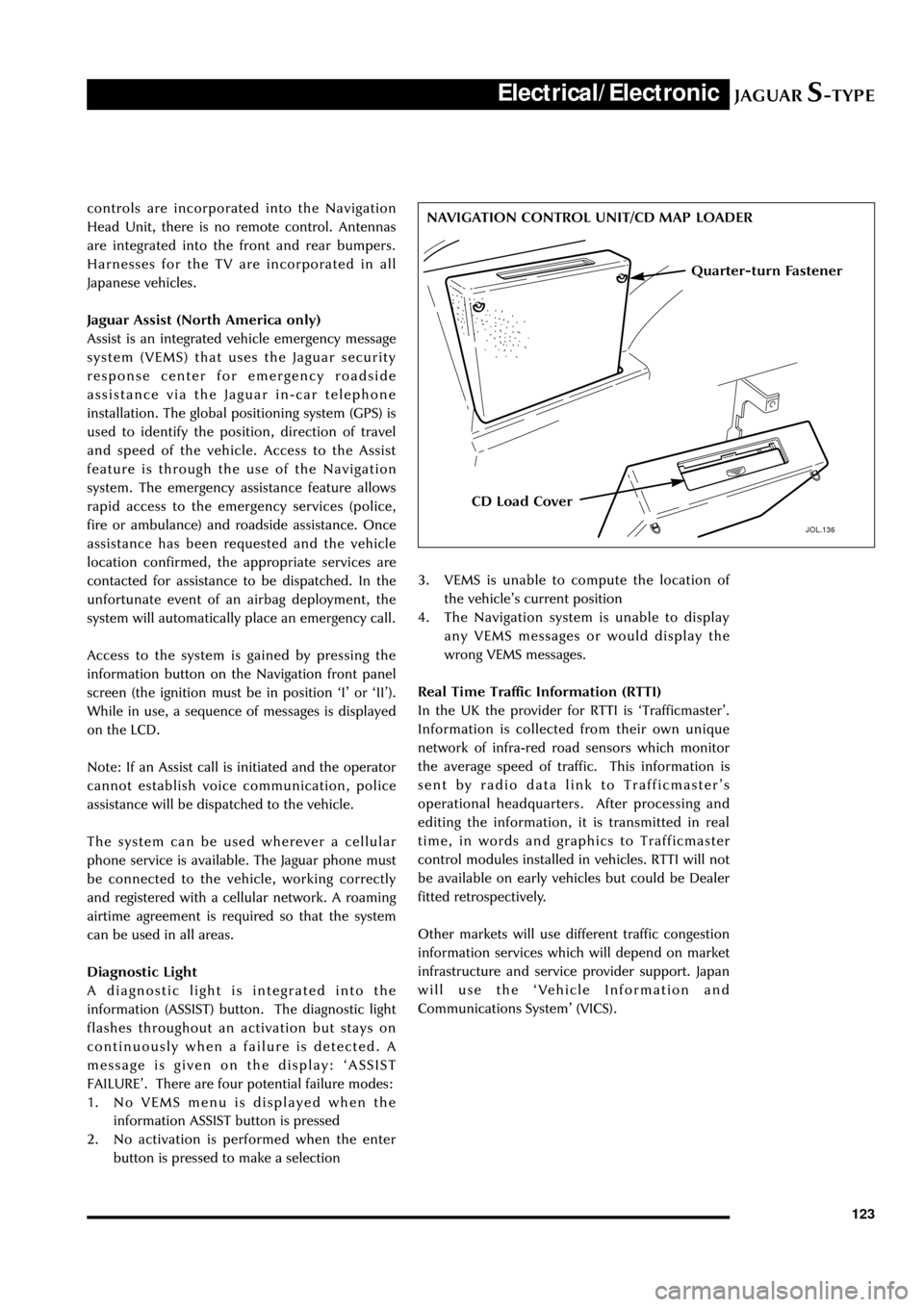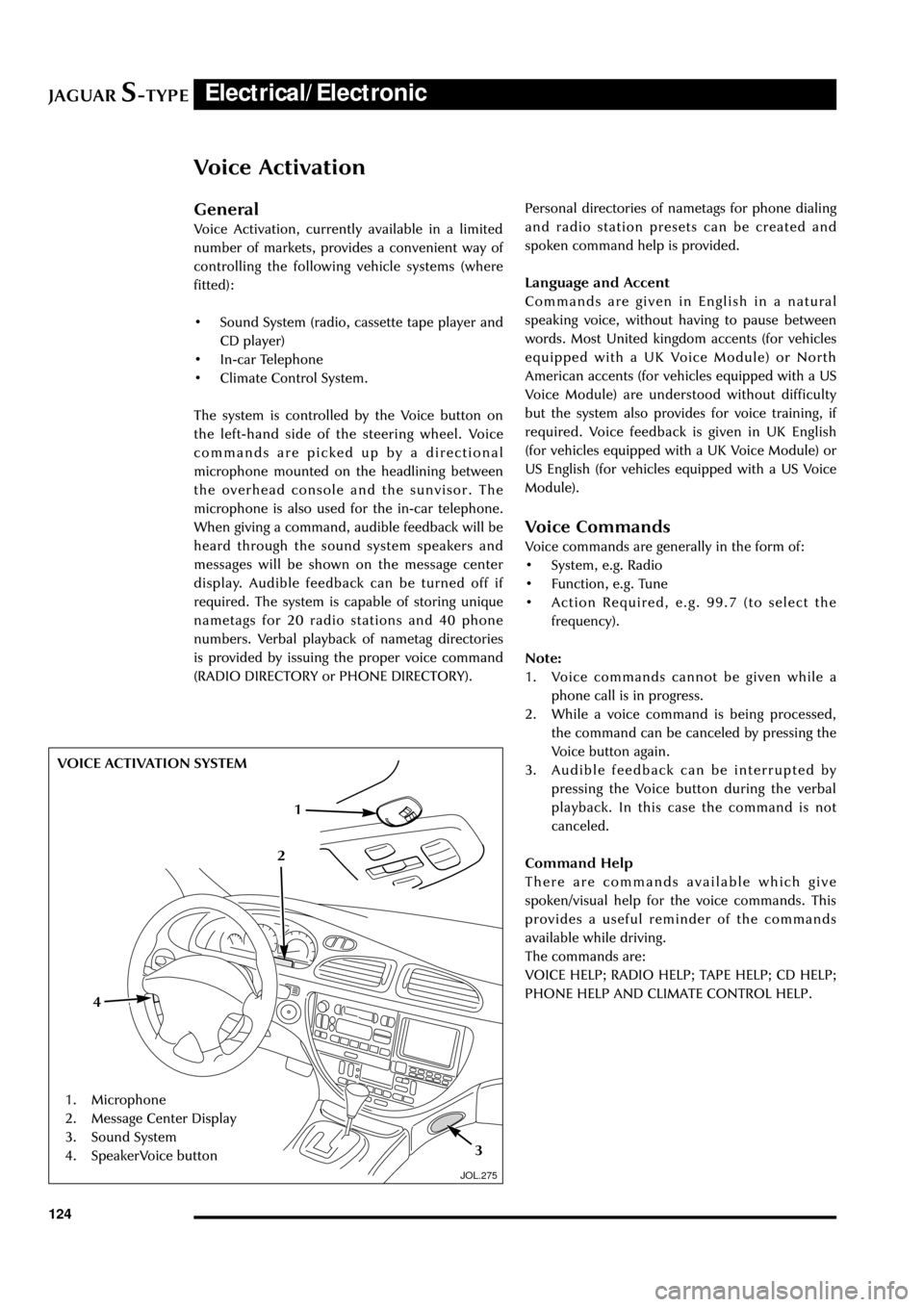radio JAGUAR S TYPE 2005 1.G Technical Guide Update
[x] Cancel search | Manufacturer: JAGUAR, Model Year: 2005, Model line: S TYPE, Model: JAGUAR S TYPE 2005 1.GPages: 133, PDF Size: 3.48 MB
Page 122 of 133

JAGUARS-TYPEElectrical/Electronic
117 The radio volume is muted to a low level when:
the Reverse Park Control is enabled by engaging
reverse gear, the Cellular phone in hands-free
mode is used, the Navigation system delivers
audible route guidance instructions or the Voice
activation system requests listening or verbal
feedback.
Audio Steering Wheel Controls
A.Audio mute and voice activation
B.Volume control
C.Radio waveband, cassette tape player and CD
tape player selection
D.Tuning/seek control:
Radio, steps through preset stations
Cassette, seeks tracks
CD, selects desired track
Premium Sound System
The Premium Sound System components differ to
the base system as follows:
¥ The head unit has the additional feature of
Digital Sound Processing (DSP) to enhance
sound quality
¥ Four enclosed 5in x 7in (127mm x 178mm)
two way door speakers, modular cassette type
¥ Two active center fill speakers (with amplifier)
¥ Active sub-woofer enclosure mounted under
the rear parcel shelf containing two sub-
woofers 5in x 7in (127mm x 178mm) and a
sub-woofer amplifier
¥ CD Changer (six disc) in the glovebox (Dealer
fit trunk position is optional).
Phone/Mute Button
Where a Jaguar in-car phone is fitted, the
phone/mute button enables the user to enter/exit
the phone mode. The display shows ÔPHONEÕ or
ÔNO PORTABLEÕ if the portable phone is not
available. Where a Jaguar in-car phone is not
fitted, the phone/mute button enables the user to
mute the sound systems output.
Digital Sound Processing (DSP Button)
The digital sound processing button has two
functions: change occupancy settings and select
special audio effects. The occupancy setting
feature provides optimum performance of the
system according to the number of vehicle
occupants.
The settings available are: Driver only, Front seats
and All seats. The audio effects, which include
Concert Hall and News Room, may be selected to
JOL.042
enhance the type of music or program being
played.
Compress Button
During CD operation, selecting Compress
compensates for ambient noise levels by
compressing the audio dynamic range to boost
quieter music and lower loud music. This can
avoid frequent adjustment of the volume control.
Shuffle Function
When the shuffle function s selected, the tracks of
the currently selected CD will be played in
random order.
A
D
C B AUDIO CONTROLS
CD CHANGER
JOL.044
Page 123 of 133

JAGUARS-TYPEElectrical/Electronic
118Menu
Press the menu button repeatedly to cycle through the first level menu functions; press the seek button
to enable / adjust the selected item. The extended menu features can be accessed by depressing and
holding the menu button for two seconds. Use the seek button to enable / adjust the selected item.
Some functions in the menu structure require the use of the volume control.
First Level Menu
Button Press Radio Tape CD
1. MAN - manual tune DOLBY ON / OFF SHUF - shuffle
2. AVC - automatic volume control AVC COMP - compress
3. *NEWS ON / OFF *NEWS ON / OFF AVC
4. *NEWS ON / OFF
* The NEWS enable / disable function is only available in MENU when the radio is in FM mode.
Second Level (Extended Menu)
Button Press Function
1 ADJUST CLOCK (hours) -adjust
2 ADJUST CLOCK (minutes) - adjust
3 12 / 24 HR CLOCK - adjust
4 TA LOCAL / TA DISTANT
5 ALT FREQ ON / OFF
6 RDS TIME ON / OFF
7 VOICETRAIN A (when fitted)
8 VOICETRAIN B (when fitted)
9 Vehicle identification number (VIN)
Security Code
The unit is protected by an anti-theft security code. Any power interruption will cause the display to
indicate ÔCODEÕ. At this point the unit will not operate until the correct security code has been entered.
The four digit security code is listed on the two security cards supplied with the vehicle. After three
unsuccessful attempts, the unit will not accept further entries until a delay of 30 minutes has elapsed.
Up to seven further attempts may be made, with a delay of 30 minutes between each, after which the
display will show ÔLOCKEDÕ.
If the security code is lost or the display shows ÔLOCKEDÕ the owner will need to return the vehicle to
the Dealer. The Dealer must ask for proof of ownership and the serial number of the unit before
supplying a security code given by contacting Jaguar Cars Ltd. To display the serial number, press and
hold preset buttons two and six simultaneously.
The remaining controls are similar to those in previous Jaguar audio systems. For specific operation of all
the controls refer to the ownerÕs Audio Systems Handbook.
Page 128 of 133

JAGUARS-TYPEElectrical/Electronic
123
JOL.136
Quarter-turn Fastener
CD Load Cover
NAVIGATION CONTROL UNIT/CD MAP LOADER controls are incorporated into the Navigation
Head Unit, there is no remote control. Antennas
are integrated into the front and rear bumpers.
Harnesses for the TV are incorporated in all
Japanese vehicles.
Jaguar Assist (North America only)
Assist is an integrated vehicle emergency message
system (VEMS) that uses the Jaguar security
response center for emergency roadside
assistance via the Jaguar in-car telephone
installation. The global positioning system (GPS) is
used to identify the position, direction of travel
and speed of the vehicle. Access to the Assist
feature is through the use of the Navigation
system. The emergency assistance feature allows
rapid access to the emergency services (police,
fire or ambulance) and roadside assistance. Once
assistance has been requested and the vehicle
location confirmed, the appropriate services are
contacted for assistance to be dispatched. In the
unfortunate event of an airbag deployment, the
system will automatically place an emergency call.
Access to the system is gained by pressing the
information button on the Navigation front panel
screen (the ignition must be in position ÔIÕ or ÔIIÕ).
While in use, a sequence of messages is displayed
on the LCD.
Note: If an Assist call is initiated and the operator
cannot establish voice communication, police
assistance will be dispatched to the vehicle.
The system can be used wherever a cellular
phone service is available. The Jaguar phone must
be connected to the vehicle, working correctly
and registered with a cellular network. A roaming
airtime agreement is required so that the system
can be used in all areas.
Diagnostic Light
A diagnostic light is integrated into the
information (ASSIST) button. The diagnostic light
flashes throughout an activation but stays on
continuously when a failure is detected. A
message is given on the display: ÔASSIST
FAILUREÕ. There are four potential failure modes:
1. No VEMS menu is displayed when the
information ASSIST button is pressed
2. No activation is performed when the enter
button is pressed to make a selection3. VEMS is unable to compute the location of
the vehicleÕs current position
4. The Navigation system is unable to display
any VEMS messages or would display the
wrong VEMS messages.
Real Time Traffic Information (RTTI)
In the UK the provider for RTTI is ÔTrafficmasterÕ.
Information is collected from their own unique
network of infra-red road sensors which monitor
the average speed of traffic. This information is
sent by radio data link to TrafficmasterÕs
operational headquarters. After processing and
editing the information, it is transmitted in real
time, in words and graphics to Trafficmaster
control modules installed in vehicles. RTTI will not
be available on early vehicles but could be Dealer
fitted retrospectively.
Other markets will use different traffic congestion
information services which will depend on market
infrastructure and service provider support. Japan
will use the ÔVehicle Information and
Communications SystemÕ (VICS).
Page 129 of 133

JAGUARS-TYPEElectrical/Electronic
124
Voice Activation
JOL.275
General
Voice Activation, currently available in a limited
number of markets, provides a convenient way of
controlling the following vehicle systems (where
fitted):
¥ Sound System (radio, cassette tape player and
CD player)
¥ In-car Telephone
¥ Climate Control System.
The system is controlled by the Voice button on
the left-hand side of the steering wheel. Voice
commands are picked up by a directional
microphone mounted on the headlining between
the overhead console and the sunvisor. The
microphone is also used for the in-car telephone.
When giving a command, audible feedback will be
heard through the sound system speakers and
messages will be shown on the message center
display. Audible feedback can be turned off if
required. The system is capable of storing unique
nametags for 20 radio stations and 40 phone
numbers. Verbal playback of nametag directories
is provided by issuing the proper voice command
(RADIO DIRECTORY or PHONE DIRECTORY).Personal directories of nametags for phone dialing
and radio station presets can be created and
spoken command help is provided.
Language and Accent
Commands are given in English in a natural
speaking voice, without having to pause between
words. Most United kingdom accents (for vehicles
equipped with a UK Voice Module) or North
American accents (for vehicles equipped with a US
Voice Module) are understood without difficulty
but the system also provides for voice training, if
required. Voice feedback is given in UK English
(for vehicles equipped with a UK Voice Module) or
US English (for vehicles equipped with a US Voice
Module).
Voice Commands
Voice commands are generally in the form of:
¥ System, e.g. Radio
¥ Function, e.g. Tune
¥ Action Required, e.g. 99.7 (to select the
frequency).
Note:
1. Voice commands cannot be given while a
phone call is in progress.
2. While a voice command is being processed,
the command can be canceled by pressing the
Voice button again.
3. Audible feedback can be interrupted by
pressing the Voice button during the verbal
playback. In this case the command is not
canceled.
Command Help
There are commands available which give
spoken/visual help for the voice commands. This
provides a useful reminder of the commands
available while driving.
The commands are:
VOICE HELP; RADIO HELP; TAPE HELP; CD HELP;
PHONE HELP AND CLIMATE CONTROL HELP.
1. Microphone
2. Message Center Display
3. Sound System
4. SpeakerVoice button
1
3
4
VOICE ACTIVATION SYSTEM
2
Page 130 of 133

JAGUARS-TYPEElectrical/Electronic
125
Using the System
Initialization
When the ignition switch is turned to position ÔIIÕ, the initialization of the system is carried out, which
takes a few seconds. When complete, the system is ready to accept voice commands. If the voice
button is pressed before initialization is complete, the message center display will show ÔVOICE NOT
READYÕ.
Audible Feedback, Confirmation & Prompts
For most voice commands, audible feedback of the command, as understood by the system, is available.
Audible feedback may be turned on or off by giving the VOICE FEEDBACK command.
For the phone dial commands, confirmation of the number, before it is dialed, may be turned on or off
by giving the PHONE FEEDBACK command. During some commands for voice training, the user is
prompted by the system to give the next item of information.
For specific operation of all the controls, refer to the OwnerÕs Voice Activation Handbook.
Voice Training
The Voice Activation System is able to interpret most English speakers without difficulty. If, however, it is
found that commands are sometimes not being recognized, the voice training procedure can be carried
out.
Voice Memories
The system has two memories (A and B) for storing the trained voices. The Voice Memory Directory
command provides an indication of the availability of the two voice memories (Full or Available).
Giving Commands after Training
After Voice training the system will automatically recognize a speaker whose voice is held in voice
memory. The system can still be used by other speakers with no loss of response.
Error Messages
In addition to the voice command prompts given by the system, the following error messages may be
encountered. The messages are shown on the message center with voice confirmation (error tone or
voice playback).
Message Explanation
NO SPEECH DETECTED The system did not detect any speech when the voice button
was pressed
NAME TAG TOO LONG A nametag must not take longer than three seconds to say
NAME TAG NOT UNIQUE The nametag (or similar sounding name) has already been
used
COMMAND NOT RECOGNIZED The command was not recognized from the list of voice
commands
HANDBRAKE MUST BE ENGAGED The handbrake must be applied for voice training
RADIO MUST BE IN TUNER MODE The sound system must be in radio mode before giving the
Radio Store command
VOICE NOT READY The voice button was pressed while the voice system was still
initializing
TOO MANY DIGITS The phone number in a Phone Enter command was too long